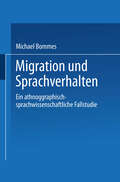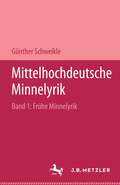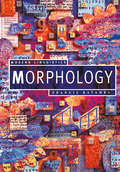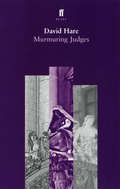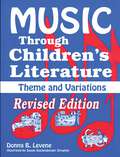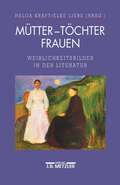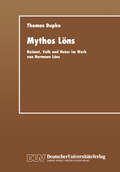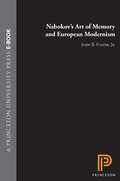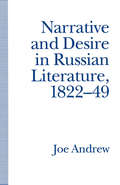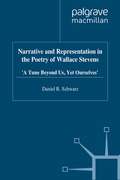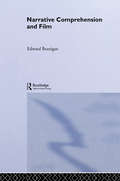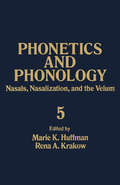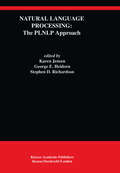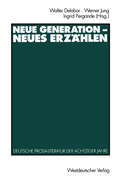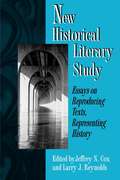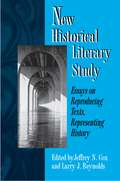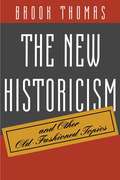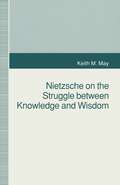- Table View
- List View
Migration und Sprachverhalten: Eine ethnographisch-sprachwissenschaftliche Fallstudie (DUV Sozialwissenschaft)
by Michael BommesMittelhochdeutsche Minnelyrik, Band I: Texte und Übertragungen, Einführung und Kommentar
by Günther SchweikleMorphology (Modern Linguistics)
by Francis KatambaMorphology is a comprehensive introduction to contemporary morphological theory and analysis in generative grammar. It contains numerous in-text exercises which involve the reader in doing morphology by analysing data from English and numerous other languages. The book is divided into three parts. Part 1 surveys traditional notions of word-structure which remain fundamental to morphological investigations. Part 2 explores the relationship between morphology and phonology in current generative grammar, while Part 3 highlights issues in the interaction between morphology and syntax.
Murmuring Judges
by David HareA young lawyer's involvement in her first case leads her through a criminal justice system - police, courts and prisons - which is cracking at the seams.Murmuring Judges is the second play in David Hare's highly acclaimed trilogy about British institutions. Racing Demon, which won four awards as Play of the Year in 1990, was the first part of the trilogy and examined the Church. The Absence of War, a play about the Labour Party, completed the trilogy.
Music through Children's Literature (Through Children's Literature)
by Donna LeveneDevelop music appreciation among your students with folk songs, rhythmic poems, stories with musical themes, and picture books with strong musical links. Designed for teaching flexibility, these lessons can be adapted according to a teacher's level of musical proficiency and time limitations. Sections cover rhythm, melody, form, instruments, music history, and dance forms, with lively activities that involve singing, playing instruments, chanting, and movement. These are perfect for the nonmusician who is teaching music as well as the seasoned music specialist.
Nabokov's Art of Memory and European Modernism
by John Burt Foster Jr.Despite Vladimir Nabokov's hostility toward literary labels, he clearly recognized his own place in cultural history. In a fresh approach stressing Nabokov's European context, John Foster shows how this writer's art of memory intersects with early twentieth-century modernism. Tracing his interests in temporal perspective and the mnemonic image, in intertextual "reminiscences," and in individuality amid cultural multiplicity, the book begins with such early Russian novels as Mary, then treats his emerging art of memory from Laughter in the Dark to The Gift. After discussing the author's cultural repositioning in his first English novels, Foster turns to Nabokov's masterpiece as an artist of memory, the autobiography Speak, Memory, and ends with an epilogue on Pale Fire.As a cross-cultural overview of modernism, this book examines how Nabokov navigated among Proust and Bergson, Freud and Mann, and Joyce and Eliot. It also explores his response to Baudelaire and Nietzsche as theorists of modernity, and his sense of Dostoevsky, Tolstoy, and Pushkin as modernist precursors. As an approach to Nabokov, the book reflects the heightened importance of autobiography in current literary study. Other critical issues addressed include Bakhtin's theory of intertextuality, deconstructive views of memory, Benjamin's modernism of memory, and Nabokov's assumptions about modernism as a concept.
Nabokov's Art of Memory and European Modernism
by John Burt FosterDespite Vladimir Nabokov's hostility toward literary labels, he clearly recognized his own place in cultural history. In a fresh approach stressing Nabokov's European context, John Foster shows how this writer's art of memory intersects with early twentieth-century modernism. Tracing his interests in temporal perspective and the mnemonic image, in intertextual "reminiscences," and in individuality amid cultural multiplicity, the book begins with such early Russian novels as Mary, then treats his emerging art of memory from Laughter in the Dark to The Gift. After discussing the author's cultural repositioning in his first English novels, Foster turns to Nabokov's masterpiece as an artist of memory, the autobiography Speak, Memory, and ends with an epilogue on Pale Fire.As a cross-cultural overview of modernism, this book examines how Nabokov navigated among Proust and Bergson, Freud and Mann, and Joyce and Eliot. It also explores his response to Baudelaire and Nietzsche as theorists of modernity, and his sense of Dostoevsky, Tolstoy, and Pushkin as modernist precursors. As an approach to Nabokov, the book reflects the heightened importance of autobiography in current literary study. Other critical issues addressed include Bakhtin's theory of intertextuality, deconstructive views of memory, Benjamin's modernism of memory, and Nabokov's assumptions about modernism as a concept.
Nabokov's Art of Memory and European Modernism
by John Burt FosterDespite Vladimir Nabokov's hostility toward literary labels, he clearly recognized his own place in cultural history. In a fresh approach stressing Nabokov's European context, John Foster shows how this writer's art of memory intersects with early twentieth-century modernism. Tracing his interests in temporal perspective and the mnemonic image, in intertextual "reminiscences," and in individuality amid cultural multiplicity, the book begins with such early Russian novels as Mary, then treats his emerging art of memory from Laughter in the Dark to The Gift. After discussing the author's cultural repositioning in his first English novels, Foster turns to Nabokov's masterpiece as an artist of memory, the autobiography Speak, Memory, and ends with an epilogue on Pale Fire.As a cross-cultural overview of modernism, this book examines how Nabokov navigated among Proust and Bergson, Freud and Mann, and Joyce and Eliot. It also explores his response to Baudelaire and Nietzsche as theorists of modernity, and his sense of Dostoevsky, Tolstoy, and Pushkin as modernist precursors. As an approach to Nabokov, the book reflects the heightened importance of autobiography in current literary study. Other critical issues addressed include Bakhtin's theory of intertextuality, deconstructive views of memory, Benjamin's modernism of memory, and Nabokov's assumptions about modernism as a concept.
Narrative and Representation in the Poetry of Wallace Stevens: A Tune beyond Us, Yet Ourselves
by D. SchwarzIn this study Daniel R. Schwarz argues that the narrative and representational aspects of Stevens's poetry have been neglected in favour of readings that stress his word play and rhetoricity. Schwarz shows how Stevens's concept of representation is deeply influenced by modern painters such as Picasso and Duchamp. He shows that Stevens's poetry needs to be understood in terms of a number of major contexts: the American tradition of Emerson and Whitman, the Romantic movement, and the Modernist tradition.
Narrative Comprehension And Film
by Edward BraniganNarrative is one of the ways we organise and understnad the world. It is found everywhere: not only in films and books, but also in everday conversations and in the nonfictional discourses of journalists, historians, educators, psychologists, attorneys and many others. Edward Branigan presents a telling exploration of the basic concepts of narrative theory and its relation to film - and literary - analysis, bringing together theories from linguistics and cognitive science, and applying them to the screen. Individual analyses of classical narratives form the basis of a complex study of every aspect of filmic fiction exploring, for example, subjectivity in Lady in the Lake, multiplicity in Letter from and Unknown Woman, post-modernism and documentary in Sans Soleil.
Narrative Comprehension And Film (PDF)
by Edward BraniganNarrative is one of the ways we organise and understnad the world. It is found everywhere: not only in films and books, but also in everday conversations and in the nonfictional discourses of journalists, historians, educators, psychologists, attorneys and many others. Edward Branigan presents a telling exploration of the basic concepts of narrative theory and its relation to film - and literary - analysis, bringing together theories from linguistics and cognitive science, and applying them to the screen. Individual analyses of classical narratives form the basis of a complex study of every aspect of filmic fiction exploring, for example, subjectivity in Lady in the Lake, multiplicity in Letter from and Unknown Woman, post-modernism and documentary in Sans Soleil.
Nasals, Nasalization, and the Velum (Phonetics and Phonology #Volume 5)
by Stephen R. Anderson Patricia A. Keating Marie K. Huffman Rena A. KrakowAlthough nasalization has been discussed in the context of more general aspects of linguistics in other books, this text is the first and primary resource focusing solely on nasalization. This volume features articles discussing all aspects of nasalization, including physiology, perception, aerodynamics, acoustics, phonetic and phonological representations, research methodology, and instrumentation. Each chapter examines important research advances achieved within the last ten years and closes with a detailed discussion of the current research.
Natural Language Processing: The PLNLP Approach (The Springer International Series in Engineering and Computer Science #196)
by Karen Jensen George E. Heidorn Stephen D. RichardsonNatural language is easy for people and hard for machines. For two generations, the tantalizing goal has been to get computers to handle human languages in ways that will be compelling and useful to people. Obstacles are many and legendary. Natural Language Processing: The PLNLP Approach describes one group's decade of research in pursuit of that goal. A very broad coverage NLP system, including a programming language (PLNLP) development tools, and analysis and synthesis components, was developed and incorporated into a variety of well-known practical applications, ranging from text critiquing (CRITIQUE) to machine translation (e.g. SHALT). This books represents the first published collection of papers describing the system and how it has been used. Twenty-six authors from nine countries contributed to this volume. Natural language analysis, in the PLNLP approach, is done is six stages that move smoothly from syntax through semantics into discourse. The initial syntactic sketch is provided by an Augmented Phrase Structure Grammar (APSG) that uses exclusively binary rules and aims to produce some reasonable analysis for any input string. Its `approximate' analysis passes to the reassignment component, which takes the default syntactic attachments and adjusts them, using semantic information obtained by parsing definitions and example sentences from machine-readable dictionaries. This technique is an example of one facet of the PLNLP approach: the use of natural language itself as a knowledge representation language -- an innovation that permits a wide variety of online text materials to be exploited as sources of semantic information. The next stage computes the intrasential argument structure and resolves all references, both NP- and VP-anaphora, that can be treated at this point in the processing. Subsequently, additional components, currently not so well developed as the earlier ones, handle the further disambiguation of word senses, the normalization of paraphrases, and the construction of a paragraph (discourse) model by joining sentential semantic graphs. Natural Language Processing: The PLNLP Approach acquaints the reader with the theory and application of a working, real-world, domain-free NLP system, and attempts to bridge the gap between computational and theoretical models of linguistic structure. It provides a valuable resource for students, teachers, and researchers in the areas of computational linguistics, natural processing, artificial intelligence, and information science.
Neue Generation — Neues Erzählen: Deutsche Prosa-Literatur der achtziger Jahre
by Walter Delabar Werner Jung Ingrid Pergande-Kaufmann8 muß eine Literatur beeinflussen -kritisch stimmen oder beruhigen. Das muß andere Themen und literarische Formen hervorbringen als die unruhigen, armen oder grau samen Zeiten. Literatur einer satten Gesellschaft? Könnte das für die junge deutsche Literatur der achtziger Jahre kennzeichnend sein? Auf einer anderen Linie liegen Schlagwörter, mit denen literarische Strömungen der vergangenen Dekaden gekennzeichnet werden: «Verdrängung», "Politisierung» und «Neue Subjektivität» für die Bundesrepublik, «Antifaschistisches Erbe», «Aufbruch», «Ankunft im Sozialismus» und «Stagnation» für die DDR. Fragwürdig sind solche Schlagwörter allemal, auffallend ist aber, daß sie mit einer einigermaßen großen Sicherheit typische literarische Phänomene erfassen sollten. Für die achtziger Jahre aber gibt es ein solches Schlagwort für keine der beiden Literaturen. Alles ist erlaubt, jedes Thema und jeder Stil, und alles wird praktiziert. Eine dominante Strö mung ist nicht zu beobachten. Die Vielfalt der Richtungen macht eine kritische Bestandsaufnahme nicht eben leicht. Im Gewirr der unterschiedlichsten Texte wird eine kategorisierende Sichtun- scheint's -nahezu unmöglich. Die Hilflosigkeit der Literaturwissenschaftler und Kri tiker sagt aber noch lange nichts über die Qualität einer Literatur aus. Unterscheidet die Literatur der achtziger Jahre irgendetwas von der alten, gibt es Traditionsbrüche und völlige Neuanfänge? Gibt es signifikante Unterschiede zwischen der bundesrepu blikanischen, österreichischen, Schweizer und der DDR-Literatur, also doch (mindestens) zwei deutsche Literaturen? Gibt es eine neue literarische Generation, einen neuen literarischen Stil, eine neue literarische Haltung? Und wird irgendetwas davon zur Kenntnis genommen?Soweit unsere Vorgaben.
New Historical Literary Study: Essays on Reproducing Texts, Representing History
by Jeffrey N. Cox Larry J. ReynoldsThis volume, growing out of the celebrated turn toward history in literary criticism, showcases some of the best new historical work being done today in textual theory, literary history, and cultural criticism. The collection brings together for the first time key representativesfrom various schools of historicist scholarship, including leading critics whose work has helped define new historicism. The essays illuminate literary periods ranging from Anglo-Saxon to postmodern, a variety of literary texts that includes The Siege of Thebes, Macbeth, The Jazz Singer, and The Chosen Place, the Timeless People, and central issues that have marked new historicism: power, ideology, textuality, othering, marginality, exile, and liberation. The contributors are Janet Aikins, Lawrence Buell, Ralph Cohen, Margaret Ezell, Stephen Greenblatt, Terence Hoagwood, Jerome McGann, Robert Newman, Katherine O'Keeffe, Lee Patterson, Michael Rogin, Edward Said, and Hortense Spillers. The editors' introduction situates the various essays within contemporary criticism and explores the multiple, contestatory issues at stake within the historicist enterprise.
New Historical Literary Study: Essays on Reproducing Texts, Representing History
by Larry J. Reynolds Jeffrey N. CoxThis volume, growing out of the celebrated turn toward history in literary criticism, showcases some of the best new historical work being done today in textual theory, literary history, and cultural criticism. The collection brings together for the first time key representativesfrom various schools of historicist scholarship, including leading critics whose work has helped define new historicism. The essays illuminate literary periods ranging from Anglo-Saxon to postmodern, a variety of literary texts that includes The Siege of Thebes, Macbeth, The Jazz Singer, and The Chosen Place, the Timeless People, and central issues that have marked new historicism: power, ideology, textuality, othering, marginality, exile, and liberation. The contributors are Janet Aikins, Lawrence Buell, Ralph Cohen, Margaret Ezell, Stephen Greenblatt, Terence Hoagwood, Jerome McGann, Robert Newman, Katherine O'Keeffe, Lee Patterson, Michael Rogin, Edward Said, and Hortense Spillers. The editors' introduction situates the various essays within contemporary criticism and explores the multiple, contestatory issues at stake within the historicist enterprise.
The New Historicism and Other Old-Fashioned Topics
by Brook ThomasBrook Thomas explores the new historicism and the challenges posed to it by a postmodern world that questions the very possibility of newness. He considers new historicism's engagement with poststructuralism and locates the former within a tradition of pragmatic historiography in the United States.
New Way, Pink Level, Parallel Books: Big Fish and Who Has My Red Fox (PDF)
by Hannie TruijensTwo short stories about a little girl; in one she loses a favourite stuffed animal, and in the other she goes fishing with her grandmother. The New Way series offers a wide range of stories - traditional and contemporary, humorous and fantastic - to appeal to today's children. nbsp;
Nietzsche on the Struggle between Knowledge and Wisdom
by K. MayIn his notes Nietzsche refers to 'The Struggle between Science and Wisdom exhibited in the ancient Greek philosophers'. Nietzsche's own view about 'science' (learning) was to the effect that, at its best, it should be greatly respected yet always tested by the demands of personal wisdom. Keith May considers the meaning and implications of Nietzsche's belief in relation to philosophy up to the time of Aristotle, and then its bearing on modern (essentially nihilistic) attitudes, to which it supplies something of an antidote.
NR360, Level 4, Upstarts: Molly and the Giant
by Betty RootThe New Reading 360 series is designed to provide a solid literary foundation for infants and build on previous literacy knowledge for juniors. Pocket books have been written to get children reading independently and for fun. They provide the opportunity to improve reading stamina and fluency.
NR360, Level 4, Upstarts: Molly and the Giant
by Betty RootThe New Reading 360 series is designed to provide a solid literary foundation for infants and build on previous literacy knowledge for juniors. Pocket books have been written to get children reading independently and for fun. They provide the opportunity to improve reading stamina and fluency.
Of Words and the World: Referential Anxiety in Contemporary French Fiction
by David R. EllisonHere David Ellison explores the problems encountered by France's best experimental authors writing between 1956 and 1984, when faced with the question: "What should my writing be about?" These years are characterized by the rise of the "new novelists," who questioned the representational function of writing as they created works of imagination that turned in upon themselves and away from exterior reality. It became fashionable at one point to affirm that literature was no longer about the world but uniquely about the words on a page, the signifying surface of the text. Ellison tests this assumption, showing that even in the most seemingly self-referential fictions the words point to the world from which they can never completely separate themselves.Through close readings Ellison examines the novels and theoretical writings of authors whose works are fundamental to our perception of contemporary French writing and thought: Camus, Robbe-Grillet, Simon, Duras, Sarraute, Blanchot, and Beckett. The result is a new understanding of the link between the referential function of literary language and the problematic of the ethics of fiction.
